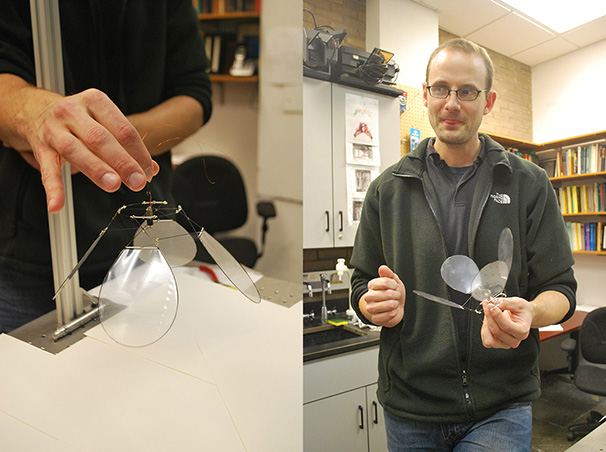
Most flying robot models currently base their design on insect-like wing motions, like those of bees, hummingbirds and moths. Instead of flapping up and down, insects sweep their wings forward, flip them over and bring them back the other way.
Leif Ristroph, assistant professor of Mathematics at NYU’s Courant Institute, has designed and created a jellyfish-like robot with flying capabilities, along with Steve Childress, retired NYU Professor Emeritus of Mathematics, and the assistance of other professors in the Department of Mathematics.
The robot, which Ristroph began building after receiving a postdoctoral fellowship from the National Science Foundation, consists of four Mylar plastic wings and is framed by carbon fiber rods. A tiny direct current electric motor spins a crankshaft around, pulls the wings in and out to make the robot fly. A part of the motor is the gearbox, which slows down power to flap wings 20 times per second, a frequency suitable for flight.
Ristroph started the project about two years ago in the Courant Institute’s Applied Mathematics lab. He and Childress iterated many varying ideas and tested them in a trial and error process. Jun Zhang, professor of physics and math, and Mike Shelley, professor of math and neuroscience, contributed their ideas to assist the process. Zhang and Shelley are co-directors of the lab and Childress is a co-founder.
Ristroph’s flying robot is the first to differ from insect-like models, instead using a closing and opening motion to move itself.
Flight stability is a main advantage of the jellyfish design. From studying their product, Ristroph discovered if their model is knocked over while in flight, perhaps from a gust of wind, it tends to come back upright.

“[Our model] is a much simpler way to fly, where keeping upright is automatically taken care of by the aerodynamics and doesn’t need any sensors or any neural circuits or anything like that,” Ristroph said.
Zhang explained how the robot’s method of flying differs from current flight technology.
“Swimming and flying is a natural phenomenon, and we always find them fascinating. But real-world fliers like an airplane or a ship that involve a steady state approach, they don’t have many moving parts,” Zhang said. “[The model] is important in sense because we better understand nature.”
The robot’s flight was filmed using two high-speed cameras to capture all of its wing motions The team can reconstruct the robot’s 3-D flight path based on the two camera views of its flight.
In the future, miniature fliers could be used for search and rescue, air quality monitoring or surveillance.
Ristroph and Childress continue to analyze the experiment even though they built a functioning flying model.
“Where we’d like to go next is actually understanding how it works. We don’t really understand the aerodynamics of it,” Ristroph said. “We got it to work, we don’t really know why in terms of the physics, so we’re still after that.”
A version of this article appeared in the Tuesday, Dec. 10 print edition. Nicole Del Mauro is a staff writer. Email her at [email protected].

























































































































































